Bokusui Wakayama in Numazu
Last week Poetry Friday found me in Numazu City in Shizuoka. So I stopped in at the memorial museum of the naturalist tanka poet Bokusui Wakayama (若山牧水 Wakayama Bokusui in Japanese name order; 1885-1928).
Bokusui Wakayama was born in Kyushu and traveled extensively around Japan and Japan's colonies, but he settled in Numazu City in his later years (a heavy drinker, he died quite young). The Numazu City Wakayama Bokusui Memorial Museum (info in Japanese here) is located near the famous beach edged with a pine forest Senbonhama (Thousand Tree Beach) that stretches along the bay and provides a buffer from storms.
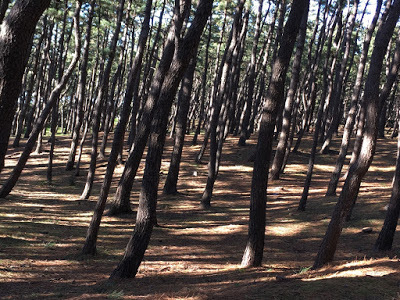
Unfortunately Numazu City was a target of American B29 bombings during WWII and in July of 1945 most of Numazu, including the home of Bokusui Wakamatsu, was razed.
But inside the museum, you can glimpse the past through photos . . .
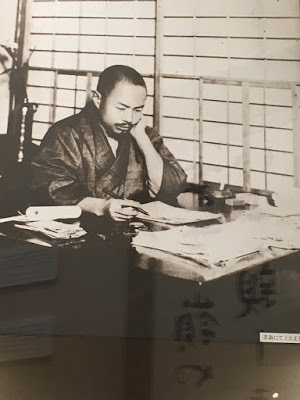 Bokusui Wakamatsu at his writing desk
Bokusui Wakamatsu at his writing desk
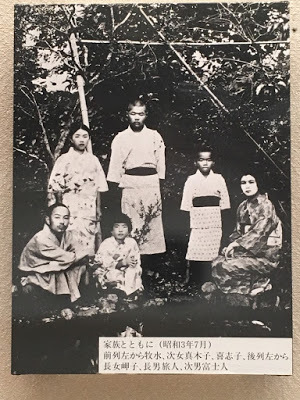 Bokusui Wakayama with his wife and four children his belongings . . .
Bokusui Wakayama with his wife and four children his belongings . . .
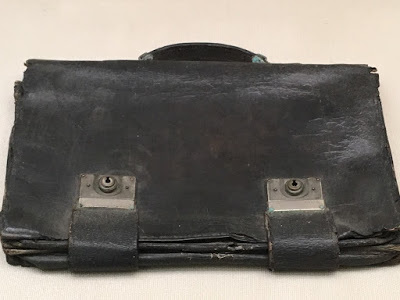 Bokusui Wakayama's satchel
Bokusui Wakayama's satchel
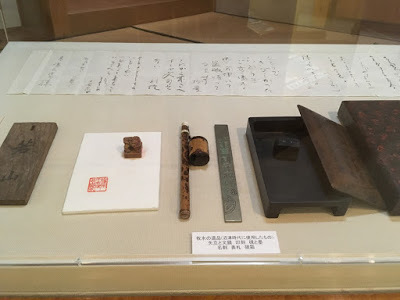 Bokusui Wakayama's writing implements and maps of his journeys through Japan.
Bokusui Wakayama's writing implements and maps of his journeys through Japan.

I loved this photo of the bay and the stretch of pine forest that Bokusui Wakayama had campaigned to preserve.
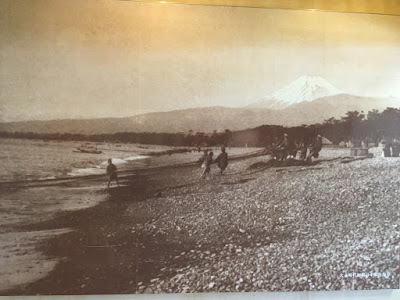
So after visiting the museum I visited the Senbonhama.

That day the wind gusts were so powerful it was difficult to walk along the seawall by the shore. Yet inside the pine forest, all was muffled.
Bokusui traveled extensively throughout Japan, so there are stones inscribed with his poems in many places. See my previous post about a stone with one of his tanka in a West Izu village.
One of Bokusui's famous poems is inscribed on a stone in Yokosuka City in Kanagawa. Click here for a page on the Bokusui Wakayama website showing photo of the stone. This poem about a seagull is from his 1908 tanka collection Umi no koe (Sea Voices).
In closing, I'd like to share an excerpt from the Japan P.E.N. Club's Digital Library "A Poet's Anthology: The Range of Japanese Poetry" with commentary and translations by poet Makoto Ōoka. About a quarter of the way into the anthology is a translation of Bokusui's white bird/seagull poem:
Bokusui Wakayama was born in Kyushu and traveled extensively around Japan and Japan's colonies, but he settled in Numazu City in his later years (a heavy drinker, he died quite young). The Numazu City Wakayama Bokusui Memorial Museum (info in Japanese here) is located near the famous beach edged with a pine forest Senbonhama (Thousand Tree Beach) that stretches along the bay and provides a buffer from storms.

Unfortunately Numazu City was a target of American B29 bombings during WWII and in July of 1945 most of Numazu, including the home of Bokusui Wakamatsu, was razed.
But inside the museum, you can glimpse the past through photos . . .
 Bokusui Wakamatsu at his writing desk
Bokusui Wakamatsu at his writing desk
 Bokusui Wakayama with his wife and four children his belongings . . .
Bokusui Wakayama with his wife and four children his belongings . . . Bokusui Wakayama's satchel
Bokusui Wakayama's satchel
 Bokusui Wakayama's writing implements and maps of his journeys through Japan.
Bokusui Wakayama's writing implements and maps of his journeys through Japan.
I loved this photo of the bay and the stretch of pine forest that Bokusui Wakayama had campaigned to preserve.

So after visiting the museum I visited the Senbonhama.

That day the wind gusts were so powerful it was difficult to walk along the seawall by the shore. Yet inside the pine forest, all was muffled.
Bokusui traveled extensively throughout Japan, so there are stones inscribed with his poems in many places. See my previous post about a stone with one of his tanka in a West Izu village.
One of Bokusui's famous poems is inscribed on a stone in Yokosuka City in Kanagawa. Click here for a page on the Bokusui Wakayama website showing photo of the stone. This poem about a seagull is from his 1908 tanka collection Umi no koe (Sea Voices).
In closing, I'd like to share an excerpt from the Japan P.E.N. Club's Digital Library "A Poet's Anthology: The Range of Japanese Poetry" with commentary and translations by poet Makoto Ōoka. About a quarter of the way into the anthology is a translation of Bokusui's white bird/seagull poem:
白鳥はShiratori wa哀しからずやkanashikarazu ya空の青Sora no ao海のあをにもumi no ao ni mo染まずただよふsomazu tadayouExcerpted from "A Poet's Anthology" (Japan P.E.N. Club Digital Library)
若山牧水Wakayama Bokusui
White bird,are you not sad ?You drift, never dyedby the blue of the seaor the sky’s azure
From Umi no Koe (Sea Voices,1908), Bokusui’s first volume of tanka, published privately the year he graduated from the English Literature Department of Waseda University. The famous poem beginning“Iku yamakawa”(How many mountains and rivers) is in the same volume.“White bird”means a seagull here. The cover illustration by Hirafuku Hyakusui must have been based on this poem. Contrasting the white of the bird to the blue of the sea and sky, the poet grieves over the bird, alive in the midst of nature’s vastness, and over his own youthful loneliness. Contemporary tanka poets avoid repetitions like“sora no ao umi no ao”(literally,“the blue of the sky, the blue of the sea”*) but in Bokusui’s poems they work wonderfully to express feeling.*Translated as “blue”and“azure”because of the shift from kanji to hiragana.―Tr.
Published on December 30, 2016 06:00
No comments have been added yet.



